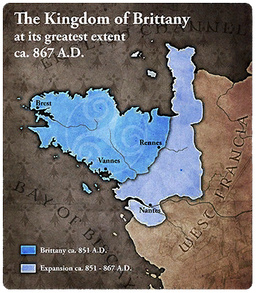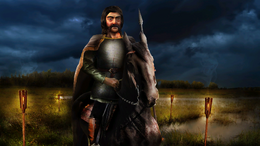| Kingdom of Brittany | |
|---|---|

| |
Map by Regalman
| |
Leader
|
Nominoe |
Capital
|
Naoned |
Start Bias
|
None |
Religion
|
Catholicism |
Culture
req. mod |
Western
|
Brittany led by Nominoe is a custom civilization mod by JFD, with contributions from TarcisioCM, DarthKyofu, Regalman and Gedemo.
This mod requires Brave New World.
Overview[]
Brittany[]
Brittany is a cultural region in the west of France, covering the western part of what was known as Armorica during the period of Roman occupation. It became an independent kingdom and then a duchy before being united with the Kingdom of France in 1532 as a province governed as if it were a separate nation under the crown.
Brittany has also been referred to as Less, Lesser or Little Britain (as opposed to Great Britain, with which it shares an etymology). It is bordered by the English Channel to the north, Normandy to the northeast, Pays de la Loire to the southeast, the Bay of Biscay to the south, and the Celtic Sea and the Atlantic Ocean to the west. Its land area is 34,023 km² (13,136 sq mi).
Brittany is the site of some of the world's oldest standing architecture, home to the Barnenez, the Tumulus Saint-Michel and others, which date to the early 5th millennium BC. Today, the historical province of Brittany is split among five French departments: Finistère in the west, Côtes-d'Armor in the north, Ille-et-Vilaine in the northeast, Loire-Atlantique in the southeast and Morbihan in the south on the Bay of Biscay. Since reorganization in 1956, the modern administrative region of Brittany comprises only four of the five Breton departments, or 80% of historical Brittany. The remaining area of old Brittany, the Loire-Atlantique department around Nantes, now forms part of the Pays de la Loire region of France.
Brittany is the traditional homeland of the Breton people and is recognized by the Celtic League as one of the six Celtic nations, retaining a distinct cultural identity that reflects its history. A nationalist movement seeks greater autonomy within the French Republic.
The Duchy of Brittany that emerged in the early 10th century was influenced by several earlier polities. Prior to the expansion of the Roman Empire into the region, Gallic tribes had occupied the Armorican peninsula, dividing it into five regions that then formed the basis for the Roman administration of the area, and which survived into the period of the Duchy. These Gallic tribes – termed the Armorici in Latin – had close relationships with the Britonnes tribes in Roman Britain. Between the late 4th and the early 7th centuries, many of these Britonnes migrated to the Armorican peninsula, blending with the local people to form the later Britons, who eventually became the Bretons. The reasons for these migrations remain uncertain. These migrations from Britain contributed to Brittany's name.
Brittany fragmented into small, warring regna, kingdoms, each competing for resources. The Frankish Carolingian Empire conquered the region during the 8th century, starting around 748 taking the whole of Brittany by 799. The Carolingians tried to create a unitary administration around the centres of Rennes, Nantes, and Vannes using the local rulers, but the kings of Brittany's hold on the region remained tenuous. Carolingian technology and culture began to influence Brittany, and the church in Brittany also began to emulate the Frankish model.
The greatest influence on the later Duchy, however, was the formation of a unitary Brittany kingdom in the 9th century. In 831 Louis the Pious appointed Nominoe, the Count of Vannes, ruler of the Bretons, imperial missus, at Ingelheim in 831. After the death of Louis in 840, Nominoe rose to challenge the new emperor, Charles the Bald, emboldened in part by new Viking raids on the empire. Charles the Bald created the Marches of Neustria to defend Western Francia from the Bretons and the Vikings. Erispoe fought Charles the Bald, who felt that a quick attack would successfully challenge the new Breton leader. Erispoe won a victory at the Battle of Jengland and, under their Treaty of Angers in 851, Brittany's independence was secured.
Nominoe[]
Nominoe was the first Duke of Brittany from 846 to his death. He is the Breton 'pater patriae' and to Breton nationalists he is known as Tad ar Vro ("father of the country").
Early in the 9th century, Nominoe, an ambitious local warlord, was made Count of Vannes. Within a decade he had united all the old feudal factions into a governable entity. So successful was he that the boundaries of the subsequent independent duchy remained largely unaltered right up to the French Revolution of 1789. Nominoe is still revered, especially in Dol-de-Bretagne, where he eventually had himself crowned King of Brittany, and in Vannes, which he made Brittany's first capital.
Dawn of Man[]
"Mighty lord Nominoe, you have been entrusted with the Breton people and their kingdom. A product of the faltering Frankish empire, your lordship over Brittany was by confirmation of the emperor Louis the Pious. But with his death, you would instead choose war; unleashing a relentless reign of violence and fury against the Frankish lands. Through your skill at battle and your cunning in politics, you would thus secure the independence and pride of your people for decades to come.

Art by TarcisioCM
Fierce warrior and father of the Bretons, lands to the east and south grow fat with gold. Can you bring plunder and turmoil to your neighbours? Can you secure Brittany's interests through fear of your name alone? Can you build a civilization that can stand the test of time?"
Introduction: "What brings you here? I am Nominoe, lord of Brittany. If you haven't gold or titles to offer, be on your way."
Defeat: "Take me lands and be way with you."
Unique Attributes[]
Brittany (Nominoe)
|
|---|
 Art by TarcisioCM Purchased units pillage at no |
 Art by TarcisioCM |
 Art by JFD |
City List
|
Spy List
|
Music[]
| Peace Theme | War Theme |
|---|---|
| "Celtic Lands", from the soundtrack of 'Rome: Total Realism' | "Warrior March", by Jeff van Dyck |

Mod Support[]
| Mod Support | |
|---|---|
| Yes | |
| Yes | |
Community Balance Patch
|
Yes |
| Yes | |
| Yes | |
Ethnic Units
|
Yes |
| No | |
| Yes | |
| Yes | |
Map Labels
|
No |
| Yes | |
| Yes | |
| Unknown | |
Unique Cultural Influence
|
Yes |
Wish for the World
|
No |
YnAEMP
|
Yes |
Full Credits List[]
| Steam Workshop Downloader | |
| Steam Workshop | |
| Latest Version: | v 1 |
| Last Updated: | 12 August 2019 |
- JFD: Author, Code, Design, Research, Text, Breseler Icon
- DarthKyofu: Civ Icon
- TarcisioCM: Leaderscene, Machtiern Icon, Leader Icon
- Regalman: Map
- Gedemo: City List
- Danrell: Unit Models
- Whoward: Utilities
- Jeff Van Dyck: Music


